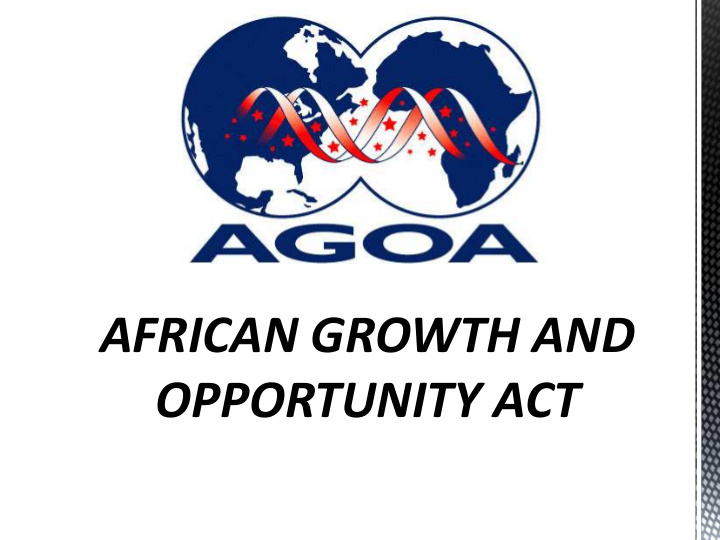



AFRICAN GROWTH AND OPPORTUNITY ACT
The Four Pillars of U.S. Policy in Africa Strengthen Democratic Institutions 1. --Promote Accountable, Transparent, and Responsive Governance Spur Economic Growth, Trade and Investment 2. --Promote an Enabling Environment for Trade and Investment --Improve Economic Governance --Promote Regional Integration --Expand African Capacity to Effectively Access and Benefit from Global Markets --Encourage U.S. Companies to Trade with and Invest in Africa Advance Peace and Security 3. --Promote and Protect Human Rights, Civil Society, and Independent Media --Promote Strong Democratic Norms, Ensure Credibility of Democratic Processes Promote Opportunity and Development 4. --Address Constraints to Growth and Promote Poverty Reduction --Increase Opportunities for Women and Youth
A Pillar of U.S. Economic Policy in Africa Economic Objectives: Spur Economic Growth, Trade and Investment 1. --Promote an Enabling Environment for Trade and Investment --Improve Economic Governance --Promote Regional Integration --Expand African Capacity to Effectively Access and Benefit from Global Markets --Encourage U.S. Companies to Trade with and Invest in Africa
Key Ongoing Presidential Initiatives Clinton Bush Obama • African Growth & • Millennium • Feed the Future Opportunity Act Challenge • Power Africa (AGOA) Corporation (MCC) • Trade Africa • President's • Young African Emergency Plan for Leaders Initiative AIDS Relief • Global (PEPFAR) Entrepreneurship • President's Malaria Summit Initiative (PMI) • PAC-DBIA
What is the African Growth and Opportunity Act? AGOA is the U. S. government’s signature trade initiative with sub-Saharan Africa. It was signed into law in May 2000 and has been re-authorized several times, most recently on June 29, 2015, until 2025. AGOA provides greater access to the U.S. market than any of our other unilateral trade preference arrangements, though not as much as under a free trade agreement. AGOA reinforces African reform efforts, provides improved access to capacity building and technical expertise through our regional Trade Hubs, and establishes an annual Ministerial dialogue on trade and investment.
What Benefits Does AGOA Offer? AGOA provides duty-free treatment to more than 6,400 products (with at least 35% African value-added): 1,800+ tariff lines in addition to the standard 4,600 available to GSP-beneficiary countries. In June, 2016, duty free treatment was extended to an additional 16 travel and luggage goods. AGOA offers duty-free and quota-free treatment for eligible value-added, namely apparel articles made in qualifying African countries. Under a Special Rule (“ Third Country Fabric ” provision), lesser-developed countries can enjoy an additional preference of duty-and quota-free access for apparel made from fabric of any origin .
AGOA Eligibility The legislation calls on the President to conduct an annual determination of beneficiary countries’ adherence to eligibility criteria. AGOA-eligible countries have to have established, or be making continual progress toward establishing: a) a market-based economy ; b) rule of law, political pluralism , and right to due process ; c) elimination of barriers to U.S. trade and investment ; d) economic policies to reduce poverty ; e) a system to combat bribery and corruption ; and f) protection of internationally recognized worker rights Countries must also not engage in activities that undermine U.S. national security or foreign policy interests; and not engage in gross violations of internationally recognized human rights .
2016 AGOA Snapshot $20,1 billion total exports; $10.6 billion under AGOA + GSP Top beneficiaries: Nigeria, South Africa, Angola, Chad, Kenya, Lesotho AGOA including GSP provisions 2016 Agricultural products Forest products Chemicals and related products Energy-related products Textiles and apparel Footwear Minerals and metals Machinery Transportation equipment Electronic products Miscellaneous manufactures Total
Trade Capacity Building USAID operates regional Trade & Investment Hubs and satellite offices to support AGOA in Nairobi, Pretoria, Gaborone, Accra, and Senegal, with an additional 7 locally-run AGOA Resource Centers throughout West Africa. www.watradehub.com www.eatradehub.org www.satradehub.org
Focus of USG Trade Capacity Building Implementation of WTO Trade Facilitation Agreement E.g., OSBPs, customs efficiencies Compliance with and harmonization of international standards E.g., SPS, TBT guidelines Promotion of trade and investment E.g., AGOA utilization strategies, export promotion, value chain / sector association support
Congress Approves AGOA Renewal President Obama signed the “Trade Preferences Enhancement Act of 2015” on June 29, 2015 re-authorizing AGOA for ten years, along with the associated “third country fabric” provision. Provided for a long term extension of AGOA including third country fabric provision; Updated the eligibility review processes; to increase transparency, participation, and flexibility Enhanced rules of origin to encourage regional “ cumulation ” Included gender promotion considerations
Key Issues for AGOA Boosting AGOA utilization in the remaining ten years. Congress strongly recommends AGOA utilization strategies. Preparing for a more reciprocal U.S.-Africa trade and investment relationship BEYOND AGOA. Congress mandates reporting on beneficiary countries’ readiness for two-way FTAs.
Background on the AGOA Forum AGOA legislation mandates that senior officials from the United States and AGOA-eligible countries meet annually to foster close economic ties and to discuss expanding trade and investment relations. This annual AGOA Forum rotates between Washington and sub-Saharan Africa. In addition to the Ministerial – the private sector, African Women’s Entrepreneurship Program (AWEP), and civil society typically host side events.
Background on the AGOA Forum Host governments, the U.S. government interagency planning committee, and the African Diplomatic Corps work together to choose a theme and develop a program. Mauritius “Trade and Investment: Tool for Growth and Development” 2003 “Expanding and Diversifying Trade to Promote Growth and Senegal 2005 Competitiveness” “As Trade Grows, Africa Prospers: Optimizing Benefits Under Ghana 2007 AGOA” “Realizing the Full Potential of AGOA through Expansion of Trade Kenya and Investment” 2009 “Enhanced Trade through Increased Competitiveness, Value Addition Zambia 2011 and Deeper Regional Integration” Ethiopia “Sustainable Transformation Through Trade and Technology” 2013 “AGOA at 15: Charting a course for a sustainable U.S. -Africa Trade Gabon 2015 and Investment Partnership.”
CALL TO ACTION: How can the YOU get involved? AGOA depends on strong civil society and private sector interest and support • Join and support the AGOA Civil Society Network: http://democracy-africa.org/ • Attend the AGOA Forum, network, and establish connections • Find out how to benefit from AGOA at http://agoa.info/toolkit.html
THANK YOU Please find more information at: http://agoa.info
Recommend
More recommend